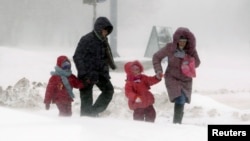Spring officially began on March 20 but many parts of the northern hemisphere remain covered with fresh snow.
Is the weather really as strange as it seems to be?
The answer is “yes.” Even meteorologists, who study and predict the weather for a living -- and have seen a lot of variations over the year -- find this year's late snow remarkable.
Paul Knightley, a senior meteorologist with the London-based MeteoGroup, says much of northern Britain is still under heavy snow cover. And that is something unseen since 1962.
He maintains that the big snowfalls late this month in Ukraine and Moscow were also unexpected.
"Farther into Europe, farther east even into Russia, we have seen lots of snow on the ground and, obviously, snow does lie in some of these places well into late March and into April,” he says. “But I think how long it has been going on for, through most of March and even into the start of April, is quite unusual."
Why spring is so late this year is uncertain. But one culprit may be the jet stream. The fast-flowing air current, which usually blows warmer Atlantic storm systems into northern Europe, has wandered far off course this year and is currently down around the Mediterranean instead.
Solar Activity
The jet stream is generated by cold air from the North Pole meeting warm air from the tropics and is supposed to blow powerfully around the globe at northern latitudes in March. But when the temperature difference between the polar and tropical air is smaller than usual, the jet steam loses power and can meander far off course -- just as it is doing now.
Just why the jet stream blows strongly at some times and weakly at others is something that meteorologists and climatologists continue to research. But Knightley suggests several factors could be responsible.
"There are a number of theories ranging from the activity of the sun,” he says. “The sun is relatively inactive at the moment as far as things like sun spots go. That is one possibility. Another one is that the Arctic regions are getting warmer as part of climate change. And if you have a warmer pole then you have a lower temperature contrast and you have a weaker jet stream."
Perhaps another reason to continue studying climate change and global warming -- things often mentioned in connection with today's seemingly unpredictable weather patterns.
But it still may not answer the question most on people's minds. That is, will spring ever arrive?
Not immediately, according to Knightley.
"Traditional computer models in meteorology can predict reasonably well between seven and 10 days ahead,” he says. “[The] models I am looking at today suggest we are not going to see any rapid rise in temperatures or any rapid melting of snow."
So, more winter at least until the first week of April. And after that, perhaps spring will finally arrive.
Is the weather really as strange as it seems to be?
The answer is “yes.” Even meteorologists, who study and predict the weather for a living -- and have seen a lot of variations over the year -- find this year's late snow remarkable.
Paul Knightley, a senior meteorologist with the London-based MeteoGroup, says much of northern Britain is still under heavy snow cover. And that is something unseen since 1962.
He maintains that the big snowfalls late this month in Ukraine and Moscow were also unexpected.
"Farther into Europe, farther east even into Russia, we have seen lots of snow on the ground and, obviously, snow does lie in some of these places well into late March and into April,” he says. “But I think how long it has been going on for, through most of March and even into the start of April, is quite unusual."
Why spring is so late this year is uncertain. But one culprit may be the jet stream. The fast-flowing air current, which usually blows warmer Atlantic storm systems into northern Europe, has wandered far off course this year and is currently down around the Mediterranean instead.
Solar Activity
The jet stream is generated by cold air from the North Pole meeting warm air from the tropics and is supposed to blow powerfully around the globe at northern latitudes in March. But when the temperature difference between the polar and tropical air is smaller than usual, the jet steam loses power and can meander far off course -- just as it is doing now.
Just why the jet stream blows strongly at some times and weakly at others is something that meteorologists and climatologists continue to research. But Knightley suggests several factors could be responsible.
"There are a number of theories ranging from the activity of the sun,” he says. “The sun is relatively inactive at the moment as far as things like sun spots go. That is one possibility. Another one is that the Arctic regions are getting warmer as part of climate change. And if you have a warmer pole then you have a lower temperature contrast and you have a weaker jet stream."
Perhaps another reason to continue studying climate change and global warming -- things often mentioned in connection with today's seemingly unpredictable weather patterns.
But it still may not answer the question most on people's minds. That is, will spring ever arrive?
Not immediately, according to Knightley.
"Traditional computer models in meteorology can predict reasonably well between seven and 10 days ahead,” he says. “[The] models I am looking at today suggest we are not going to see any rapid rise in temperatures or any rapid melting of snow."
So, more winter at least until the first week of April. And after that, perhaps spring will finally arrive.
